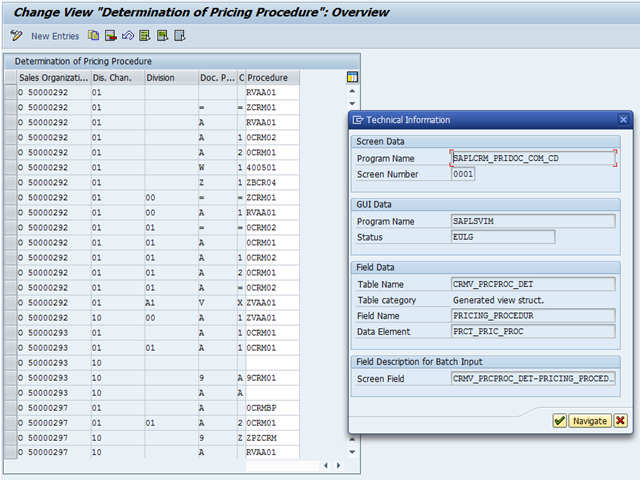Okay, let’s continue…
Via the technical name of table fields in the customizing (SPRO), we could easily get the tables for each mapping parts I mentioned in the first part of this blog.

Table storing mapping between sales area, document pricing procedure and customer pricing procedure and the pricing procedure: table CRMC_PRCPROC_DET and CRMC_CPRICPROC in view CRMV_PRCPROC_DET. Useful fields: CLIENT, SALES_ORG, DIS_CHANNEL, DIVISION, DOC_PRIC_PROC, CUST_PRIC_PROC and PRICING_PROCEDUR.
Table storing pricing procedure data: PRCC_COND_PP (integrated in view PRCV_CONDSCHEMED) , Useful fields: KAPPL (application: CRM), KALSM (Pricing procedure, same type as PRICING_PROCEDUR) and KSCHL (Pricing - Condition Type)
Table storing condition type and the related access sequences: /SAPCND/T685 and PRCC_COND_CT (in view PRCV_CONDTYPE), Useful fields: KSCHL (Pricing – condition type), KAPPL, KDZGF (Access Sequence, only exists in /SAPCND/T685)
Table storing access sequences and mapped accesses: /SAPCND/T682I (in view /SAPCND/V1_T682I). Useful fields: KOZGF (Access Seq.), KAPPL and KOTABNR (Condition table)
The mapping of condition table keyword and full name could be found in table /SAPCND/T681. Useful fields: KAPPL, KVEWE (Condition Technique), KOTABNR (Keyword) and KOTAB (Condition table name).
Then it should not be a big job to write a report to get and calculate the final estimated condition record tables will be actively used in the system.
Or you just go through the above tables in SE16 and manually get the final results.
(end)